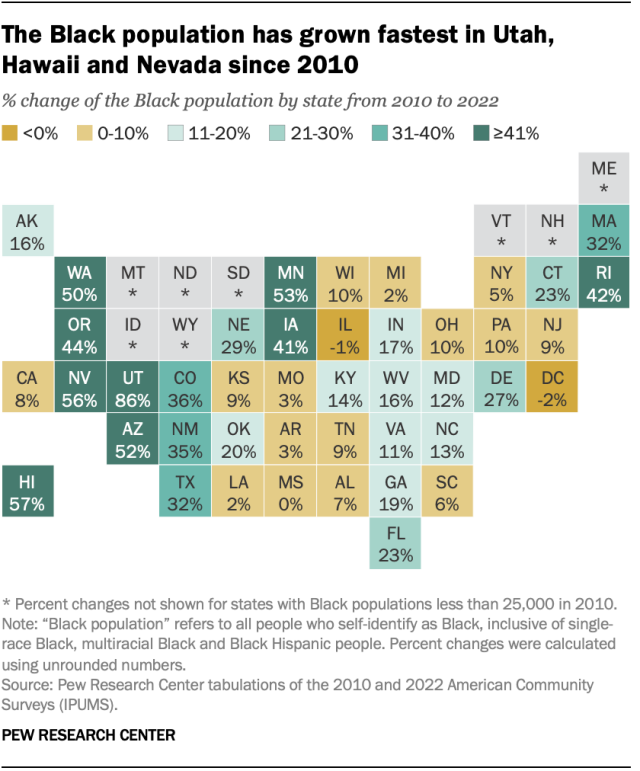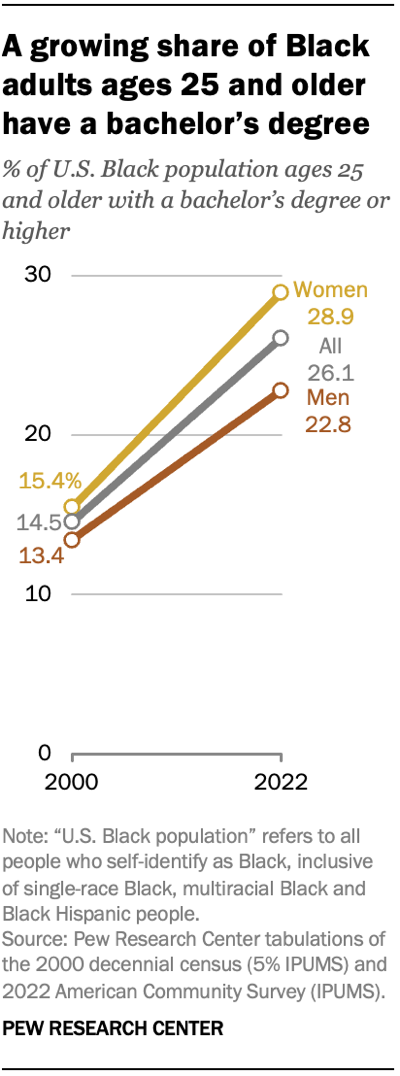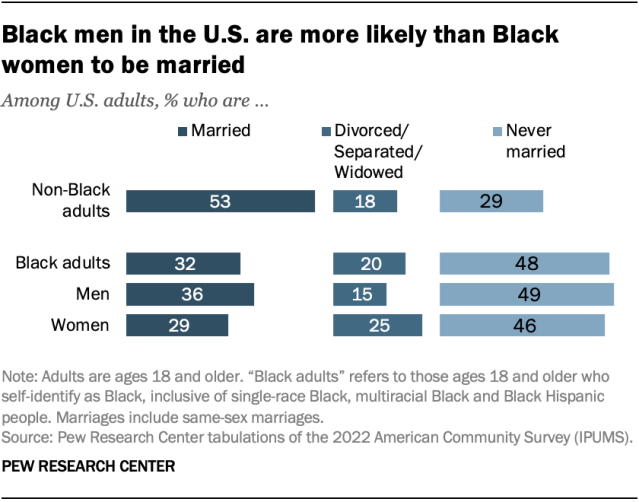
The number of Black people living in the United States reached a new high of 47.9 million in 2022, up about a third (32%) since 2000, according to a Pew Research Center analysis of government data. This group is diverse, with a growing number and share born outside the U.S. and an increasing number saying they are of two or more races.
For Black History Month, here are key facts about the nation’s Black population. In this analysis, the Black population is made up of three main groups: single-race, non-Hispanic Black people; non-Hispanic, multiracial Black people; and Black Hispanics. You can also read our newly updated fact sheet about Black Americans in 2022.
This analysis is based on Pew Research Center tabulations of microdata from the Census Bureau’s 2022 American Community Survey, provided through the Integrated Public Use Microdata Series (IPUMS) from the University of Minnesota. The analysis identifies the nation’s Black population through self-reports of racial and ethnic identity on the 2022 ACS. The Black population includes single-race non-Hispanic Black people, multiracial non-Hispanic Black people and those who say they are Black and Hispanic. All displayed numbers are rounded. Shares and percent changes are calculated using unrounded numbers.
The analysis relies on respondent self-identification of race and ethnicity in the Census Bureau data sources such as the 2022 American Community Survey (ACS) to identify the nation’s Black population. The racial and ethnic categories used in census data have changed over time – including question wording, format and instructions – and may affect how people identify by race and ethnicity. Read “What Census Calls Us” for more details on how U.S. racial and ethnic categories have changed since 1790. Moreover, respondents’ perceptions of the questions and their own racial and ethnic identity can change in response to individual circumstances and the way the nation sees race and itself. Starting in 2000, Americans could select more than once racial category in census forms. Before that, many multiracial people were counted in only one racial category.
Analyses of race and ethnicity of spouses can only be done for those spouses residing in the same household; that is, the spouse does not have a separate official residence, is not stationed away from home with the military, is not institutionalized, etc. For married Black adults, 91% reside with their spouse.
U.S. Black population or total Black population refers to the population of Americans who self-identify as Black in the United States. This includes those who say their race is only Black and that they are not Hispanic; those who say Black is one of two or more races in their identity and they are not Hispanic; and those who say they are Hispanic or Latino and either Black alone or in combination with other races. The terms Black population and Black people are used interchangeably.
Adults refers to those who are ages 18 or older.
The terms single-race, non-Hispanic Black; Black alone, non-Hispanic; and single-race Black are used interchangeably to refer to the same population. This population is made up of individuals who self-identify only as Black and do not identify as Hispanic or Latino.
The terms multiracial, non-Hispanic Black and multiracial Black are used to refer to people who self-identify as two or more races and do not identify as Hispanic or Latino.
The term Black Hispanic is used to refer to those who self-identify as Hispanic or Latino and as Black, either alone or in combination with other races. This group is not the same as the nation’s Afro-Latino population as not all Black Hispanics identify as Afro-Latino and not all Afro-Latinos identify as Black or Hispanic.
Foreign born refers to persons born outside of the United States to parents neither of whom was a U.S. citizen. The terms foreign born and immigrant are used interchangeably.
U.S. born refers to persons born in the 50 states, the District of Columbia, Guam, Puerto Rico, or the U.S. Virgin Islands. The term also refers to those born abroad to a parent who was a U.S. citizen.
The Black population in the U.S. has grown by 32% since 2000, rising from 36.2 million then to 47.9 million in 2022. Notably, the number of people self-identifying as another race in addition to Black has increased nearly 254% since 2000. This reflects a broader national shift in the number of Americans identifying as multiracial, as well as changes to how the U.S. Census Bureau asks about race and ethnicity. The number of Black Americans who say they are Hispanic has also risen sharply over this period, up 199% since 2000.

The arrival of new immigrants from Africa, the Caribbean and elsewhere has been an important contributor to Black population growth. In 2022, there were 5.1 million Black immigrants in the U.S., up from 2.4 million in 2000, according to our analysis of Census Bureau data. Immigrants accounted for 11% of the Black population in 2022, up from 7% in 2000.
The Black population has grown fastest in states that historically have not had large numbers of Black residents. Utah experienced the fastest growth in its Black population between 2010 and 2022, with an increase of 86%. The Black populations of Hawaii and Nevada increased by 57% and 56%, respectively, during that span. (This only counts states with Black populations of at least 25,000 in 2010.)

The states that experienced the largest numerical increases in Black residents between 2010 and 2022 are also those with the largest Black populations overall: Texas (which saw growth of 1 million Black residents between 2010 and 2022); Florida (up 745,000) and Georgia (up 595,000). Each of these states now has a Black population larger than that of New York, which ranked first in 2010.
Meanwhile, the Black population declined in the District of Columbia (-2%) and Illinois (-1%) between 2010 and 2022.
New York City has more Black residents than any other metropolitan area. About 3.6 million Black Americans live in the New York metro area. Other metro areas with large Black populations include Atlanta (2.2 million), Chicago (1.7 million) and Washington, D.C. (1.6 million).
As a share of the population, the Atlanta area is home to a higher percentage of Black people than any other metro area with at least 1 million Black residents. Nearly four-in-ten residents of the Atlanta metro area (36%) are Black. The next highest shares are the metro areas of Washington (28%), Detroit (24%) and Philadelphia (23%).

The Black population of the U.S. is relatively young. In 2022, the median age of Black Americans was 32.1 years, meaning half of the nation’s Black population was younger than that age and half was older. By comparison, the median age of the nation overall was 38.0 that year.
The median age among single-race, non-Hispanic Black Americans was 34.9 in 2022, compared with 21.0 among Black Hispanics and 19.5 among multiracial, non-Hispanic Black Americans.
Educational attainment among Black Americans is on the rise. In 2022, 26.1% of Black adults ages 25 and older – 7.8 million people – had earned at least a bachelor’s degree. That was up from 14.5% in 2000.

Growing shares of Black women and Black men alike have earned at least a bachelor’s degree. But Black women have made faster gains than Black men.
In 2022, 28.9% of Black women ages 25 and older had earned at least a bachelor’s degree, up from 15.4% in 2000. Among Black men in the same age range, by comparison, 22.8% had earned at least a bachelor’s degree in 2022, up from 13.4% in 2000.
Black Americans are less likely than other Americans to be married. About a third of Black adults (32%) are currently married. That compares with 53% of adults who are not Black.
Among Black adults, 36% of men are married, compared with 29% of women. Black women, in turn, are slightly more likely than Black men to be divorced (14% vs. 10%) or widowed (8% vs. 2%).

About a sixth of married Black adults (17%) are married to someone who is not Black. This includes 21% of married Black men and 13% of married Black women. These shares only consider those who are married and whose spouses live in the same households.
Married Black women, in turn, are more likely than married Black men to have a spouse who is also Black (87% vs. 79%). This includes spouses who are single-race Black, multiracial Black and Black Hispanic.

Black households had a median annual income of $50,000 in 2022. That included a median income of $60,000 among multiracial Black households, $56,500 among Black Hispanic households and $49,500 among single-race Black households.
Looked at another way, about half of all Black households (51%) had a household income of $50,000 or more in 2022, while 49% earned less than that.
Meanwhile, a recent Pew Research Center analysis found that Black households made gains during the pandemic when it comes to wealth – the difference between the value of assets owned and debts owed. The typical single-race, non-Hispanic Black household saw a 77% increase in its wealth from December 2019 ($15,300) to December 2021 ($27,100).
Note: This is an update of a post originally published Feb. 10, 2023.




